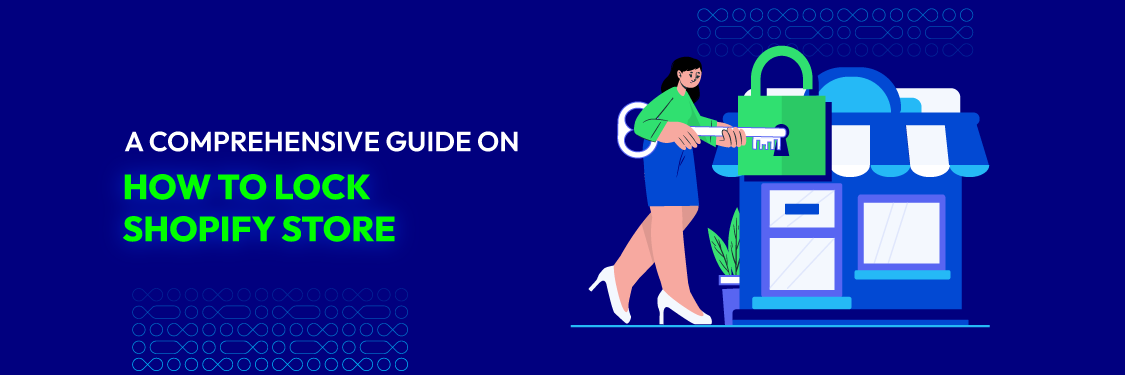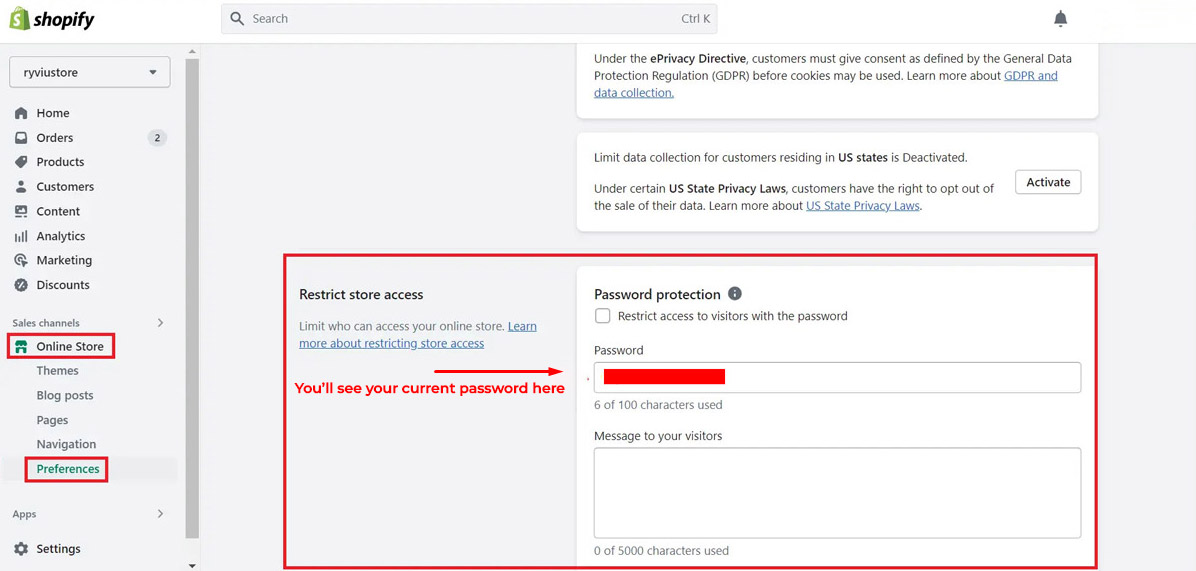A Comprehensive Guide on How to Lock Shopify Store
Summer Nguyen | 01-15-2024

Picture this: you have invested a great deal of time and money into making your online store the best it can be, only to find out later that security has been compromised. The consequences could be a disaster ranging from financial losses to damages to the reputation of your business.
In this comprehensive guide, we’ll address an important yet often ignored topic: how to lock Shopify store. We’ll unveil the essential steps to fortify your Shopify store against unauthorized access, ensuring your business thrives in a secure digital landscape.
Table of Contents
- Why do you need to lock your Shopify store?
- How to lock Shopify store effectively?
- General FAQs about locking Shopify store
- Work with Mageplaza to secure your Shopify store
- Final thoughts
Why do you need to lock your Shopify store?
Before answering the question of how to lock Shopify store, let’s take a look through why we should implement it. Shopify store security is essential for several reasons, not the least of which is that it has an immediate effect on your online business’s credibility and authenticity.

The following are some significant details that emphasize how important Shopify store security is:
- Customer trust and reputation. Security issues may expose payment information and other sensitive consumer data, damaging customer trust and your company’s reputation.
- Financial protection. Secure Shopify stores protect your, your clients, and your company’s sensitive financial information, including credit card information, from potential financial losses and legal consequences if disclosed.
- Legal compliance. E-commerce businesses are required to adhere to data protection laws, which can lead to legal errors and fines if they fail to do so.
- Prevention of data leaks. Safety measures for Shopify stores assist in preventing hacking, illegal access, and data leaks. Protecting client information, order information, and other sensitive business data requires this.
- Secure payment processing. A secure payment gateway is necessary for online store security since Shopify handles online transactions and guarantees its security to stop fraudulent activity and unauthorized access.
It is impossible to overestimate the significance of Shopify store security. Also, it is essential not only for safeguarding your clients and your business’s success but also for assuring the long-term viability of your online company.
Read more: 3D Secure Shopify: Boosting Payment Security for E-commerce Success
How to lock Shopify store effectively?
Method 1: Set up the password page
Making a password-protected page is essential for keeping your Shopify store safe while it’s being developed or maintained. During setup, testing, or updates, it is especially helpful since it limits access to the website, making it available only to those who possess the password.
Here’s how to set up a password page:
- Step 1: Access your Shopify admin dashboard.
- Step 2: On the menu on the left, select “Online Store.”
- Step 3: Then, click on “Preferences.”
- Step 4: Next, scroll down to the Password Protection section.

- Step 5: Turn on the password security.
- Step 6: Enter a password that visitors will need to input to access the store.
- Step 7: Lastly, select “Save” from the menu to apply for password protection.
From now on, anyone trying to access your Shopify store will be required to enter the password.
Method 2: Use an app
How to lock Shopify store? Follow this second method. To further protect the operation of your website, you can lock your Shopify store using an app. The steps listed below will help you safeguard your Shopify store using an app:
- Step 1: Choose a trustworthy Shopify App Store app to securely lock your store. One of the best recommendations is the EasyLockdown ‑ Wholesale Locks app.

- Step 2: Choose an app from the Shopify App Store and follow its installation instructions, which typically involve clicking buttons and granting necessary permissions.
- Step 3: After installation, navigate to the app’s settings in your Shopify admin dashboard and locate a new tab for configuring features, including store-locking functionality.
- Step 4: You can modify the setting of the locking system that secures your store using the app’s settings according to your safety requirements and preferences. Here are some main features:
- Password protection. Select a strong password that only authorized personnel can access, enhancing security by preventing unauthorized access.
- IP whitelisting. Specify IP addresses that can access the store without encountering a lock, which is beneficial for dedicated teams working from specific locations.
- Time-based restrictions. Some apps allow you to set specific time frames for your store to be accessible. This is helpful if you want to restrict access during non-business hours or maintenance.
- Step 5: To ensure the program works effectively and that the shop is safe for allowed customers while blocking illegal access, thorough testing is necessary before implementing the lock.
- Step 6: After completing the app’s configuration and testing, activate the store-locking feature by toggling a switch or taking specific actions within the app settings.
- Step 7: Make sure your store is consistently accessible, and make any necessary adjustments to the app’s settings. Also, keep an eye out for store security and update the app whenever there are changes to the staff or operations.
By following these steps, you can effectively use a Shopify app to lock your store and enhance its security, protecting your business and customer data from uninvited entry.
Read more: 11 Ways to Strengthen Your eCommerce Store’s Security
General FAQs about locking Shopify store
If you’re still concerned about your Shopify store’s security, continue reading the following frequently asked questions about locking your store.
Will customers be discouraged if they see a locked store?
Yes, customers can be discouraged if they see a Shopify store that is locked. Consider the below factors before locking your store:
- Clear Communication: If you need to lock your store, clearly communicate the reason and estimated timeframe to your customers. Use a prominent banner or message on your storefront and consider sending an email to your subscribers.
- Alternative Contact: Provide a way for customers to contact you with questions or concerns while your store is locked. This could be an email address, phone number, or contact form.
- Strategic Timing: Avoid locking your store during peak shopping hours or major holidays unless absolutely necessary.
Will locking my Shopify store affect my SEO?
Yes, locking your Shopify store can affect your SEO, but the extent of the impact depends on how you lock your store and for how long.
If you use Shopify’s built-in password protection feature, search engines like Google won’t be able to crawl and index the content of your store. This means your product pages, collection pages, and other content won;t appear in search results. However, your homepage with the password form might still appear in search results.
If you choose third-party apps, this situation may be different. Some third-party apps offer more advanced store locking options, but they can also impact your SEO. For example, if an app completely blocks search engine bots, it can prevent your content from being indexed. But there are some apps that offer alternative locking methods that are more SEO-friendly. They might only hide the “Add to Cart” button or restrict access to certain pages while still allowing search engines to crawl the rest of your site.
In addition, the impact also depends on the length of time you lock your Shopify store. A short-term lock likely won’t have a significant impact on your SEO. However, a long-term lock can hurt your rankings because search engines won’t be able to access your content.
What happens if I forget the password?
If you forget the password you used to lock your Shopify store, don’t worry – you can easily reset it. Follow these steps:
- Log in to your Shopify account using your email address and password.
- Click on “Online Store” in the left sidebar, then select “Preferences.”
- In the “Password protection” section, you’ll see your current password. Click the “Change password” button.
- Type in your new password twice to confirm it, then click “Save”.

Can I set different passwords for different customers?
Yes, you can set different passwords for different customers in your Shopify store but this method requires coding knowledge or the help of a developer because you’ll need to add a bit of Liquid code to your theme to display a password prompt for specific customer tags and check the entered password against the correct one.
Work with Mageplaza to secure your Shopify store
Partnering with a trusted Shopify development agency like Mageplaza can elevate your store’s security to the next level. Our team of experts can implement tailored solutions, from customizing access controls to fortifying your store against potential threats. With Mageplaza’s focus on security best practices and regulatory compliance, you can rest assured that your business is in capable hands.
Mageplaza’s Shopify Support and Maintenance Services prioritize security, ensuring your store runs smoothly. Here are the reasons why you should choose us:
- Starting from $399/month, have Shopify experts handle all the technical challenges to keep your website running smoothly.
- The Mageplaza team brings 10 years of experience in eCommerce and a deep understanding of the Shopify ecosystem.
- Our priority is 24/7 support, ensuring our customers receive immediate assistance in any urgent situation.
- Mageplaza employs dedicated progress tracking tools to maintain effective communication with our valued customers.
Contact Mageplaza today for a free consultation and get help from our Shopify experts now!
Final thoughts
To sum up, we hope that you have found the solution to our main question – How to lock Shopify store. Throughout this article, we have covered two incredibly powerful ways to secure your Shopify store and boost its security measures against outside attacks.
By the instructions we have mentioned above, you can strengthen your online business’s security by preventing unwelcome access and preventing hackers that could probably leak your business’ sensitive information outside.
Remember, proactive security measures are extremely important. Regularly updating password protocols, monitoring access logs, and staying updated on security developments help secure your Shopify store and build trust with customers, ensuring their data is safe.





![Top 20+ Must-have Shopify Apps for 2025 [Free & Paid] - Mageplaza](https://cdn2.mageplaza.com/media/blog/must-have-shopify-apps/top-must-have-shopify-apps.png)
![[2025 Updates] Top 10+ Upsell Apps for Shopify - Mageplaza](https://cdn2.mageplaza.com/media/blog/best-upsell-shopify-app/cover.png)
